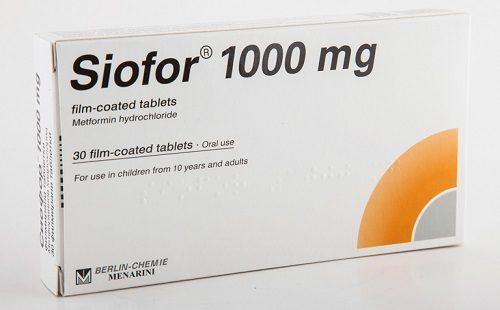The content of the article
Means like Metformin - biguanides - are a modified molecule of guanidine - the main component of the herb called Goat's medicinal. So these substances are almost natural, and the need for modification of guanidine at one time was dictated by its extremely toxic effect on the liver.
However, the first biguanides represented only a slightly lower health hazard, giving pronounced side effects on the liver, pancreas and digestive tract. The use of bovine and porcine insulin to compensate for diabetes nearly “buried” biguanides, since insulin is free from such deficiencies.
However, over time, interest in biguanides returned, mainly due to the opening of Metformin. This remedy is toxic to the liver or pancreas only in combination with some other drugs, and separately - no. The use of Metformin is accompanied only by negative effects on the stomach and intestines, as well as an increase in the concentration of lactic acid in the blood.
Release forms and analogues
Metformin has many trade names (absolute counterparts). The tool can also be called:
- "Launcher";
- “Glibometom” (contains glibenclamide);
- "Glycomet";
- Gliminfor;
- Gliformin;
- Glucophagus
- "Glucofage";
- "Dianormet";
- “Diformin”;
- "Metfogamma";
- Sioforom.

In the countries of the former USSR, the best known options are Siofor, Metformin and Glyukofazh. Often, consumers add to the name an indication of the dosage of the active substance, for example: “Metformin” 500; "Metformin" 850. And manufacturers sometimes indicate their company in the name of a medicine.
As a result, the name of the drug takes on this form:
- "Metformin-Teva";
- "Metformin-Canon";
- Metformin Richter.
Composition and scope of Metformin
The composition of the drug "Metformin" may vary depending on the wishes of the manufacturer. Its basis is the active substance itself, and among the auxiliary components may include: magnesium stearate, talc, starch and povidone adsorbent.
Without a prescription, a drug in pharmacies should not, in theory, be dispensed with. But in practice, it is considered safe enough to make periodic exceptions to this rule.
Act
"Metformin" does not affect the speed or volume of insulin production by islet cells (they are also called islets of Langerhans). But it reduces:
- the release of glucose from food;
- absorption of glucose by the walls of the intestine;
- blood coagulability (blocks fibrinogen - a coagulating plasma protein).
Plus, it accelerates the oxidation of fats in the liver, and hence their metabolism.
Indications
Official medicine does not recommend the use of Metformin for weight loss for those who suffer not so much overweight as overly picky attitude to their figure. And all because of its side effects, comparable to the harm from the most radical diets.
But the endocrinologist has the right to prescribe a medicine in certain cases of obesity, for example, if it is caused by the following conditions:
- Diabetes mellitus. Especially its insulin-independent form. Obesity with it shows a number of characteristic “diabetic” features: increased fat deposition on the body, including the “withers” in the seventh vertebra on the neck, as well as thin extremities (fat and muscle on them, due to peripheral deterioration, compared to the massive body) blood flow). Obesity in diabetes mellitus is an optional phenomenon, in many respects depending on the measures of its compensation undertaken by the patient. The more significant place physical exercises occupy in it, the less it will be noticeable, and vice versa.
- Polycystic ovary. A hormonal phenomenon that occurs in about 10-12% of women of childbearing age. In PCOS (polycystic ovary syndrome), obesity develops as a result of the body’s natural attempt to compensate for ovarian failure by increasing estrogen background (estrogens are metabolized and “stored” in adipose tissue). In addition, jumps in blood pressure, facial hair growth, and deposition of fat mass in the male type (on the abdomen, and not on the hips) are typical for this disease. They are caused by a deficiency of estrogen in the blood of a woman suffering from PCOS.
- Menopause. The normal extinction of the reproductive function, which is accompanied by a change in the hormonal background and its inevitable consequences. One of them is a quick set of fat mass - on equal terms for men and women, although pathological forms of “postmenopausal” obesity are more common in women.

A serious reason is the fact that Metformin is prescribed as not a primary but an auxiliary agent:
- Uterine endometriosis. Endometriosis is the pathological proliferation of its mucous membrane. This condition is often combined with fibromyoma, a benign neoplasm in its cavity. Both processes are considered hormone-dependent, although traumatic or hereditary factors can often be found among their causes. Therefore, the ability of Metformin to normalize excess estrogen activity in overweight women has a beneficial effect on the progress of endometriosis and fibromyoma.
- Localized cancer. In recent years, the anticancer properties of Metformin have been actively investigated. Clarification of their nature would allow for wider use of the drug in oncology. At first, Metformin’s positive effect on the prognosis and rehabilitation of patients with cancer of the stomach, breast, pancreas, prostate, liver and endometrium was simply noted. Indication for the use of Metformin in the above types of cancer is due to the fact that it stimulates cell apoptosis (a mechanism of cellular self-destruction that does not work in cancer cells). In addition, the drug is able to inhibit the proliferation (division) of any cells, optionally malignant. The main version of the origin of these properties today is that Metformin blocks the entry of sugar into the cells - the main catalyst for all processes of metabolism, growth and division for healthy and malignant cells.True, part of these effects is achieved due to the negative impact of Metformin on individual organs and systems. So, its anticarcinogenic effect on the prostate in men is explained by the ability to lower testosterone levels, which is easily achieved by standard hormonal therapy. Prevention of pancreatic cancer using Metformin has not yet been recommended (only the fight against an existing tumor). The reason is that its long-term use alone leads to chronic pancreatitis (precancerous condition, especially in diabetics).
Metformin treatment is also prescribed for patients with hepatitis and non-alcoholic obesity of the liver.
The essence of the relationship between these conditions and diabetes mellitus is not entirely clear to science, but there is an assumption that fatty hepatosis is somehow associated with increasing insulin resistance. In addition, his progression and prognosis may be affected by the patient's passion for sweets on fructose, the excess of which is deposited in the liver in the form of glycogen and fat.
Features of using the product to reduce weight
Practice shows that the safety of Metformin is still in doubt. For example, this is due to its ability to provoke inflammation in a healthy pancreas.
Contradictory data on its effect on the functioning of the nervous system. Some studies provide evidence that Metformin activates "sleeping" stem cells, which allows it to be used to treat many age-related pathologies, including atherosclerosis and senile dementia.
Others point to its ability to reduce the absorption of vitamin B12 from food, which entails the development of peripheral neuropathy. And in 2017, systematic results of several studies were obtained. They showed that Metformin treatment significantly increased the likelihood of developing Parkinson's disease, although it is not yet clear why.

Contraindications and complications
Among the contraindications given in the instructions for use of "Metformin" and any drugs based on it, there are necessarily a number of conditions:
- Lactic acidosis. Lactic acid poisoning, normally secreted by the muscles with active contraction. Lactic acid is a product of cellular respiration, and its accumulation causes pain in the muscle fiber after physical exertion. Usually it is excreted by the kidneys, but for some reasons this may not happen (there is too much lactic acid, kidney function is impaired). This complication is fatal and requires immediate medical attention. An overdose of Metformin itself can provoke an increase in the concentration of lactic acid in the blood. And the presence of lactic acidosis even before the start of its administration automatically excludes Metformin from the list of drugs approved for the patient.
- Renal failure. As a catalyst for acidosis and other side effects associated with the accumulation of the drug in the tissues and the delay in its elimination.
- Hypoglycemic coma. A characteristic feature of diabetes mellitus arising from critically low blood glucose levels. Hypoglycemia can be associated with severe restrictions on the amount of carbohydrates consumed per day (diabetics count them in bread units), excess insulin injected once, excessive physical exertion, or even a long break between meals (nocturnal hypoglycemia). Metformin limits the absorption of glucose into the blood and its production in the liver.That is, its action enhances the symptoms of hypoglycemia, accelerates the onset of coma (the brain cannot work without sugar) and increases the likelihood of death.
- Ketoacidosis. Also called “fruit breath” and characteristic of uncompensated diabetes mellitus, strict diets, and cases of prolonged hunger. Ketone bodies are chemical relatives of acetone, formed during the breakdown of the body's own proteins / cells (this happens during hunger when the body "eats" itself). They are extremely toxic to the kidneys and brain. The action of Metformin is aimed at creating an additional deficiency of glucose in the blood and cells. So, he is only able to accelerate the formation of ketone bodies.
- Hypoxia. In particular, caused by insufficiency of the heart or lungs, which leads to oxygen starvation. It can cause the aforementioned lactic acidosis, extremely unsuccessfully supplementing the action of Metformin.
- Large-scale infections. As well as febrile and other acute conditions of an established / unidentified nature, not related to sugar levels and requiring the appointment of other drugs.
- Alcoholism. Or sharing alcohol with Metformin. Diabetes mellitus and ethyl alcohol are incompatible because it is a strong activator of digestion and glucose uptake, increases the risk of hypoglycemia. And one of the by-products of ethanol metabolism in the liver is lactic acid, the level of which is also increased by physical exertion, hypoxia and the use of Metformin in large doses. Thus, the Metformin combination plus alcohol results in a rapid increase in lactic acidosis even when they are used in moderate doses.

Other restrictions
In addition to the official list of contraindications of Metformin, there is also an unofficial one - not specified in the instructions.
- Pregnancy and Breastfeeding. The negative effect of Metformin on the fetus was not found, since it does not penetrate the placenta or breast milk, remaining strictly within the digestive tract. But research on this topic is clearly not enough. Therefore, it is more reasonable for expectant mothers to take care of themselves and the child, especially in the early stages of pregnancy.
- Insulin resistance. The first and main purpose of the drug. The American Diabetes Association conducted a study in 2012 on the effectiveness of Metformin compared to physical activity. She divided the subjects with prediabetes (non-critical, growing insulin resistance) into four groups. The first received a placebo instead of Metformin and did not go in for sports, the second received only Metformin, and the third and fourth received a placebo or Metformin in combination with physical activity. The result was unexpected, because the group that took a placebo and did sports showed the best result in increasing the sensitivity of cells to insulin compared to the control group (taking only a placebo). And the groups that were treated for insulin resistance only with “Metformin” or “Metformin” in combination with physical activity were worse than the group “only sports”, although it was assumed the opposite. And the researchers were forced to assume that the negative effect of “Metformin” on the functioning of the nervous system leads to the fact that the increase in the “appetite” of cells on glucose during physical activity is partially offset by the use of “Metformin” instead of supplementing it. This means that traditional lifestyle changes with prediabetes are more effective than Metformin treatment.
Officially, the most common side effects of Metformin are bloating, abdominal pain, diarrhea and a metallic taste in the mouth, and loss of appetite. They disappear during the first week or two after the start of its intake.
Weight Loss Reception
Despite all doubts about the effect of Metformin on various processes in the body, endocrinologists are increasingly appointing it to “accelerate” the diet results for overweight or obese patients without signs of insulin resistance. However, reviews about the Metformin tablets and the results of weight loss with their help are mixed.
Most of them are positive, since the course of Metformin nevertheless leads to a decrease in body weight and the achievement of the desired proportions. But the side effects that arose at the beginning of its administration sometimes go to the chronic stage.

Plus, the average weight loss rate observed by the “experimenters” on one Metformin is about 5 kg per month, while many diets bring the same result. And on short mono-diets, weight loss can amount to 7 kg per week, for which they are designed.
Moreover, the probability of the seriousness of side effects of Metformin and radical diets is approximately the same, and in terms of their reversibility, diets win several points.
Thus, the question of which Metformin is the most effective for weight loss is incorrect for two reasons at once:
- he is the same everywhere - and acts the same (only its manufacturer differs);
- for weight loss he is undesirable - since banal squats and calorie restrictions can achieve the same results, but much safer.
As for how to take Metformin for weight loss, you should start by using 500 mg of the drug once a day, at night, after dinner. Weekly dosage should be increased by 500 mg and stopped at 3 g per day. The total weight loss course on Metformin should not be more than three consecutive months.
There are different ways to relate to the existing contradictions of Metformin. One thing is clear: it is under active study. It is likely that the collected observation results will later lead to the appearance of improved means of this series.
But now taking Metformin for weight loss, if this goal is not related to type 2 diabetes, means risking the aggravation of existing metabolic disorders and digestive diseases.

